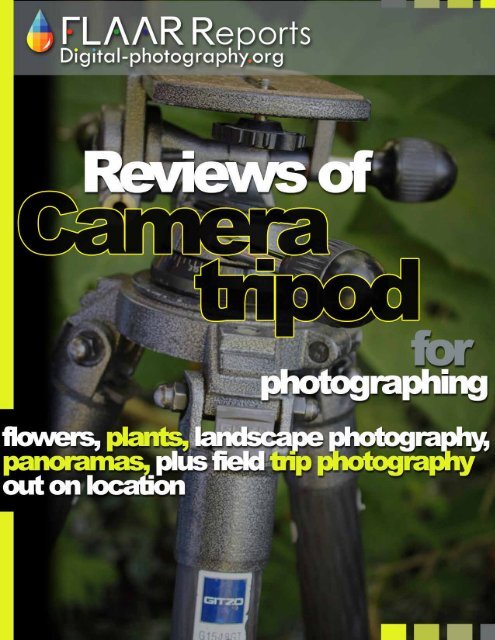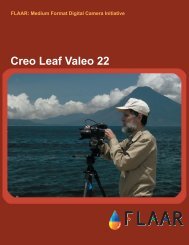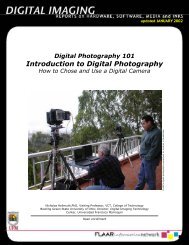Reviews of camera tripods for photographing flowers plants - Digital ...
Reviews of camera tripods for photographing flowers plants - Digital ...
Reviews of camera tripods for photographing flowers plants - Digital ...
Create successful ePaper yourself
Turn your PDF publications into a flip-book with our unique Google optimized e-Paper software.
Linking, Downloading and Sharing policy<br />
If you’re an educator in any college or university, or an <strong>of</strong>ficial in any scientific society,<br />
museum, botanical garden, zoo or comparable, and want to distribute copies<br />
<strong>of</strong> FLAAR Reports on digital photography (www.digital-photography.org), on Maya<br />
archaeology, ethnobotany or ethnozoology (www.maya-archaeology) or wide-<strong>for</strong>mat<br />
inkjet printing (www.large-<strong>for</strong>mat-printers.org) to your staff or students, please just let<br />
us know so that can authorize the distribution.<br />
If your museum, university, college, botanical garden, or zoo want to receive all<br />
FLAAR reports in the future (similar to a subscription <strong>for</strong>mat), there will be no charge<br />
if you arrange a distribution system <strong>for</strong> your institution by linking to our www.digitalphotography.org<br />
or www.maya-archaeology.org (currently available only <strong>for</strong> museums,<br />
universities, and comparable).<br />
There is no cost <strong>for</strong> distributing this report, but it is preferable that the system is<br />
authorized by FLAAR publications. We prefer that the link to the actual download<br />
comes through our web page. In other words, you can link to our web page whereby<br />
the PDF can be downloaded at no cost.<br />
This report is not intended to be put onto any other web site (other than museum, university,<br />
botanical garden, zoo) and only when authorized. This report is not available<br />
to be placed on other web sites (that are not a recognized educational resource).<br />
One reason our reports are not intended <strong>for</strong> being copied is that this report may have<br />
been updated and we have no way to provide updates if we don’t know (via communication)<br />
who is posting our PDFs.<br />
To get a legitimate version we suggest you get it from www.maya-archaeology.org,<br />
www.digital-photography.org or our new site in 3D technology that covers 3D scanning<br />
<strong>of</strong> cultural heritage, ethno-botanical and ethno-zoology, www.3d-scanners-3ds<strong>of</strong>tware-reviews.org.<br />
Updates and improvements<br />
If you find any errors or permission in this report, or if you know anything that we<br />
missed, please let us know to consider it. Write to FrontDesk@FLAAR.org<br />
2
Contents<br />
3<br />
About 94% <strong>of</strong> the photographs on this report were taken with a Gitzo tripod 4<br />
Why use a tripod at all? 5<br />
But, when is using a tripod not a good idea? 5<br />
To achieve better photographs 6<br />
Gitzo <strong>tripods</strong> 6<br />
Which <strong>tripods</strong> does FLAAR use already? 7<br />
What <strong>tripods</strong> would we like to evaluate? 8<br />
Comments: which tripod features to skip: 10<br />
Gitzo tripod accessories 12<br />
Manfrotto <strong>tripods</strong> 13<br />
NOVOFLEX QuadroPod “tripod” 13<br />
What about other brands <strong>of</strong> <strong>tripods</strong>? 14<br />
Final comments on <strong>tripods</strong> 15<br />
Appendix A 17<br />
Gitzo G1504 MK2 17<br />
Gitzo G1127 18<br />
Gitzo G2257 18<br />
Gitzo G1548GT 18<br />
Gitzo G1348 19<br />
We at FLAAR Reports review <strong>tripods</strong> on several other web sites 19<br />
3
About 94% <strong>of</strong> the photographs on this report were<br />
taken with a Gitzo tripod<br />
Perhaps 2% were taken with a Manfrotto <strong>tripods</strong> <strong>of</strong> other brands.<br />
About 4% were taken with no tripod at all.<br />
If you notice that the photographs <strong>of</strong> <strong>flowers</strong>,<br />
<strong>plants</strong>, trees, fruits and vegetables on this web<br />
site are a bit better than photographs on many<br />
other botanical web sites, it is because we<br />
• Use a tripod<br />
• Usually use a cable release<br />
• Use good lighting (reflectors or flash outside;<br />
Westcott digital fluorescent in the studio)<br />
• We have the lighting come from the best angle<br />
possible<br />
• We take the time to seek a photogenic situation<br />
• We have as a goal to do more than just-take-aphoto<br />
• On the Hasselblad Zeiss lenses, always do a<br />
mirror pre-release lock-up<br />
The other reason is probably that FLAAR Reports<br />
has over 42 years experience <strong>of</strong> photography<br />
in Guatemala, Mexico, Belize, and Honduras.<br />
The purpose <strong>of</strong> our pages on digital photography<br />
are to give to botanists, ethnographers, and<br />
archaeologists the benefits <strong>of</strong> our experience.<br />
Many capable photographers understandably<br />
don’t want to tell competitors their secrets. But<br />
FLAAR is a non-pr<strong>of</strong>it institute and our goal is to<br />
share what we know.<br />
This new web page is also available as a PDF;<br />
the PDF version has many more photographs<br />
Gitzo G2257 Explorer tripod.<br />
(that would not fit on a single web page). The<br />
reason <strong>for</strong> this new web page (and the PDF) is<br />
that we visited PhotoPlus <strong>camera</strong> equipment expo <strong>for</strong> several days in New York this autumn, and felt<br />
it would be helpful to photographers if we wrote our evaluation <strong>of</strong> the <strong>tripods</strong> that were being <strong>of</strong>fered<br />
by manufacturers compared to our 40+ years <strong>of</strong> experience using <strong>tripods</strong>.<br />
4
The purpose <strong>of</strong> this FLAAR evaluation is to assist photographers to make their decisions.<br />
Why use a tripod at all?<br />
Thousands <strong>of</strong> photographers achieve gorgeous<br />
photographs with no tripod. But I<br />
use a tripod <strong>for</strong> close to 98% <strong>of</strong> my shots if<br />
I have a tripod available. My assistants are<br />
being trained to use <strong>tripods</strong> as well, but this<br />
takes practice and patience to get them to<br />
swith to using <strong>tripods</strong>.<br />
The only time I don’t use a tripod is when a<br />
special permit is required (such permits are<br />
ridiculously expensive and since FLAAR<br />
rarely sells our photos, we are not making<br />
money from our photography).<br />
When non-tripod users are questioned about<br />
why they don’t use a tripod, most say that<br />
a tripod ties them down. You can be more<br />
spontaneous without a tripod. Yes…, but<br />
once you get accustomed to having a tripod<br />
always, you will develop spontaneity with the<br />
tripod.<br />
I once went on a field trip to photograph<br />
the colorful doors and window shutters on<br />
a Greek island. The person with me said “I<br />
don’t need a tripod because my Canon <strong>camera</strong><br />
lenses have stabilization, etc, etc.<br />
At the end <strong>of</strong> the trip, after he saw my photos,<br />
and compared them with his photos, he<br />
said, “Now I see why you use a tripod.” In<br />
other words, lens stabilization is better than<br />
none, but lens stabilization is NOT enough to<br />
beat using a tripod.<br />
Ievgenia Nemirova, a Ukrainian student <strong>of</strong> architecture,<br />
using a Gitzo G1348 MK4.<br />
5
But, when is using a tripod not a good idea?<br />
If your tripod is cheap, wobbly, or in whatever way inadequate, this can diminish the quality <strong>of</strong> your<br />
photos.<br />
And, if you don’t use a cable release,<br />
your finger will cause shake (even if the<br />
<strong>camera</strong> is on a tripod).<br />
The most common problem I see in<br />
young photographers is that they never<br />
use a cable release and their legs,<br />
arms, hands, and fingers are totally<br />
entangled with the tripod.<br />
But, when is using a <strong>camera</strong> tripod not<br />
a good idea?<br />
If your tripod is cheap, wobbly, or in<br />
whatever way inadequate, this can<br />
diminish the quality <strong>of</strong> your photos.<br />
And, if you don’t use a cable release,<br />
your finger will cause shake (even if the<br />
<strong>camera</strong> is on a tripod).<br />
The most common problem I see in<br />
young photographers is that they never<br />
use a cable release. And their legs,<br />
arms, hands, and fingers are totally<br />
entangled with the tripod. So they are<br />
shaking their tripod and causing the<br />
<strong>camera</strong> to move even when the use a<br />
tripod.<br />
Jennifer Lara a FLAAR photographer, assembles Gitzo G1127 MK2.<br />
FLAAR Photo Archive.<br />
No, that is the wrong way to use a<br />
tripod. MOVE AWAY from your tripod.<br />
Never be anywhere near your tripod.<br />
Use a cable release so there is no<br />
excuse even to touch your <strong>camera</strong>.<br />
6
To achieve better photographs<br />
If you are only sending photos to family and<br />
friends, you probably can do without a tripod,<br />
since few will notice the difference. But<br />
if you wish your photos to stand out, and if<br />
you ever intend to enlarge them, be sure to<br />
• Have a solid tripod that does not wobble.<br />
• A raised center post is the most common<br />
cause <strong>of</strong> wobble. Most <strong>of</strong> my Gitzo <strong>tripods</strong><br />
deliberately don’t even have a center bar.<br />
• Use a cable release.<br />
• Use a mirror-lockup mode <strong>for</strong> taking each<br />
photograph.<br />
• Keep your hands and body away from the<br />
tripod while you take your photograph.<br />
Gitzo <strong>tripods</strong><br />
In North America, we tend to do photography<br />
in the Ozark Mountain area. So we may<br />
be <strong>photographing</strong> on a hillside, or in a creek.<br />
Thus the Gitzo tripod ability to move its legs<br />
to any position is essential.<br />
In Guatemala we are also doing digital<br />
photography in rough terrain, so the ability<br />
<strong>of</strong> a Gitzo tripod to put its legs down, or<br />
sideways, is crucial. Once you have used a<br />
tripod with this capability, you would never<br />
accept any lesser brand or model.<br />
Gitzo G1127 tripod Explorer.<br />
7
Which <strong>tripods</strong> does FLAAR use already?<br />
Our first tripod, a Tiltall, was great<br />
when I was in college, but once<br />
I went pro, I jumped to Gitzo. My<br />
photos that were published by<br />
National Geographic back in the<br />
1970’s were all taken with a Gitzo<br />
tripod. And since then I have another<br />
40+ years more experience<br />
with many other Gitzo and one<br />
Manfrotto tripod.<br />
My first Gitzo, although at pro level,<br />
was not perfect <strong>for</strong>ty years ago,<br />
and their then US distributor was<br />
not as hospitable and helpful as is<br />
Manfrotto Distribution today (Manfrotto<br />
Distribution is the rebranding<br />
<strong>of</strong> Bogen Imaging). So that<br />
early model is long ago replaced<br />
by more robust and longer-lasting<br />
Gitzo <strong>tripods</strong>.<br />
Not one <strong>of</strong> my Gitzo pro-level <strong>tripods</strong><br />
since then has worn out: one<br />
had a leg broken when the leg was<br />
stuck over a meter deep in muck at<br />
the bottom <strong>of</strong> a crocodile-infested<br />
swamp near the Pacific Ocean<br />
coast in a mangrove area. We<br />
were doing large-<strong>for</strong>mat panorama<br />
photos <strong>of</strong> the sacred water lily<br />
there, and when we tried to pull the<br />
tripod out <strong>of</strong> the deep mud the leg<br />
got stuck and the assistant, moving<br />
the tripod back and <strong>for</strong>th, cracked<br />
the leg at the support.<br />
This was his fault, and not a defect<br />
<strong>of</strong> the tripod.<br />
Ievgenia Nemirova, a volunteer from Ukraine assembles Gitzo G1348<br />
MK4. Monterrico Guatemala June 2010.<br />
There are seven in our full photo team, and each size and kind <strong>of</strong> <strong>camera</strong> and lens works best with a<br />
different tripod.<br />
8
Wimberly plamp + Gitzo G1348 MK2 Mountaineer Inter-Pro Studex<br />
tripod + Arca-Swiss Ballhead.<br />
• Gitzo G1504 MK2, the weight is<br />
an asset as a studio tripod. Has<br />
G528 geared center column.<br />
• Gitzo G1127 MK2, lightweight<br />
and perfect low height, great <strong>for</strong><br />
traveling out on location<br />
• Gitzo G2257 Explorer, carbon<br />
fiber tripod; unique “clasp” locking<br />
system at top<br />
• Gitzo G1548GT, ideal <strong>for</strong> my<br />
Hasselblad and Phase One<br />
• Gitzo G1501 MK2 Tele Studex,<br />
(probably the one damaged by<br />
assistant in the crocodile swamp)<br />
What <strong>tripods</strong><br />
would we like to<br />
evaluate?<br />
We photograph:<br />
• Mayan archaeology artifacts<br />
• Architectural history (in China,<br />
Thailand, Guatemala)<br />
• Giant jungle trees, sacred <strong>flowers</strong><br />
<strong>of</strong> the Maya, tropical fruits,<br />
curious vegetables <strong>of</strong> Central<br />
America<br />
• Insects, spiders, scorpions:<br />
jaguars, crocodiles and howler<br />
monkeys; vultures, herons, macaws;<br />
crabs and shellfish<br />
So it helps to have really really<br />
tall <strong>tripods</strong> (<strong>for</strong> <strong>flowers</strong> up in trees)<br />
and really low <strong>tripods</strong> <strong>for</strong> insects<br />
under rotting logs, and mid-sized<br />
<strong>tripods</strong> <strong>for</strong> normal photography.<br />
Especially since there are several excellent photographers on our staff, and since we each are doing<br />
a different subject with a different <strong>camera</strong>, it helps to have a diverse range <strong>of</strong> <strong>tripods</strong>.<br />
9
Here is Nicholas <strong>photographing</strong> ants on the ground, Now you can see why we need a low-level tripod. Hardly<br />
anyone makes a support system <strong>for</strong> photography at this low a position. The “low” supports are fine, but the tripod<br />
heads are all far too high. Rio Dulce area, Izabal, Guatemala, November 2011.<br />
For intermediate level photographers it would help to evaluate something a bit higher than the nice<br />
Gitzo G1227 so perhaps a Gitzo GT2542L or GT2531. I must admit that I prefer the traditional top<br />
click positions <strong>of</strong> the leg latch (the old-fashioned Gitzo innovation from the original French company).<br />
For really showcasing what a Gitzo can do (and what you won’t get from a lesser brand), we would<br />
like to evaluate the fllowing from December onward:<br />
Gitzo GT5561SGT with GS5510XLS Telescopic center column or,<br />
GT3541XLS, “Extra long tripod” with GS5510XLS Telescopic center column, or<br />
GT5561SGT, “Giant Tripod” with GS5510XLS Telescopic center column. This we would use when<br />
<strong>photographing</strong> tropical fruits or <strong>flowers</strong> that bloom only high up in trees. We bring a ladder along with<br />
us on all field trips. We sure could publish remarkable photographic results if we had a tripod like this.<br />
10
Nicholas <strong>photographing</strong> Flor de Mayo - Plumeria with a G1348 MK2 Mountaineer Inter-Pro Studex tripod + Arca-Swiss<br />
tripod head Canon EOs 1Ds Mark III + 100mm macro Canon lens. Parque Nacional Tikal July 2011.<br />
Gitzo GT3320BS, “baby tripod” since we photograph insects on the ground, such as leaf-cutting ants<br />
(especially when they are harvesting <strong>flowers</strong>).<br />
Caption (Rio Dulce recent trip, or Sayaxcha earlier this year): Here is Nicholas <strong>photographing</strong> ants on<br />
the ground.<br />
Comments: which tripod features to skip:<br />
Every photographer will have their favorite features and accessories. So what I will now discuss are<br />
my personal preferences. But you may be <strong>photographing</strong> under other conditions. For example, if you<br />
are primarily in a studio, then you don’t have to worry about transporting your tripod weight around<br />
the world.<br />
11
Nicholas <strong>photographing</strong> out in the jungle with a G1348 MK2 Mountaineer Inter-Pro Studex tripod + Hasselblad<br />
ELX <strong>camera</strong> with a Phase One P25+. Sayaxché Guatemala June 2011.<br />
If you are only <strong>photographing</strong> outside but still in your own local area, then you will not have the issues<br />
we do: mangrove swamps, climbing up and down mountains, or out in remote rain <strong>for</strong>ests.<br />
If you take your tripod out on field trips, I suggest all <strong>tripods</strong> be without a wind-up handle. Any handle<br />
is just one more item to snag, break <strong>of</strong>f, or otherwise become a headache. A handle is not needed (I<br />
have had National Geographic publish my photos taken with Gitzo <strong>tripods</strong> with no handle!).<br />
Flip-locks <strong>for</strong> changing the angle <strong>of</strong> the legs are a real pain, especially when at the top <strong>of</strong> the tripod<br />
leg. This is why I only use Gitzo <strong>tripods</strong> and no longer any system that has a flip-lock at the top. The<br />
Gitzo system allows you to move the legs to many positions without having to flip, lock, or unlock anything.<br />
You only need to pull the clasp out at the start <strong>of</strong> the day if you think you will later need to put<br />
the leg into an extreme horizontal position.<br />
12
Why is a locked-leg-position-system-a-headache? Because not many assistants will take the time<br />
to bother to flip up the lock to move the leg angle. They will simply <strong>for</strong>ce the leg (leaving the lock<br />
clamped). Of course this wears out even a well made lock.<br />
All this is one reason I much prefer Gitzo<br />
<strong>tripods</strong>.<br />
You read comments from people who are<br />
not accustomed to how to extend the legs<br />
and tighten them up. Once you get used<br />
to it, you won’t even think <strong>of</strong> it any more.<br />
When I have a giant butterfly in front <strong>of</strong><br />
me, nested on a gorgeous tropical flower,<br />
I just want to get my tripod into position:<br />
I know how to lengthen, or shorten, my<br />
tripod supports. Besides, with a Gitzo, just<br />
spread the legs further apart (which you<br />
can use because <strong>of</strong> the innovative clicksystem<br />
at the top <strong>of</strong> each leg. I really love<br />
this engineering concept.<br />
Gitzo tripod<br />
accessories<br />
You can opt <strong>for</strong> a spike at the end <strong>of</strong> your<br />
tripod supports (to get into the soil). You<br />
can opt <strong>for</strong> a wide foot (especially <strong>for</strong> a<br />
monopod, but probably usable <strong>for</strong> tripod<br />
as well?). There are plenty <strong>of</strong> accessories<br />
both <strong>for</strong> Gitzo and Manfrotto <strong>tripods</strong>. I tend<br />
to be Spartan and not use too many accessories<br />
(they either get lost, or get left in<br />
the main studio: I have drawers filled with<br />
equipment accessories from past years;<br />
who knows even <strong>for</strong> what equipment they<br />
were original made <strong>for</strong> a decade ago).<br />
But there are several accessories that I<br />
recommend. I discuss these in our separate<br />
page on tripod heads. http://www.maya-ethnobotany.org/<br />
Jennifer Lara, using and inspecting Gitzo <strong>tripods</strong> up the<br />
Arroyo Petex Batun, tributary <strong>of</strong> Rio de la Pasion, near<br />
Sayaxche, El Peten, Guatemala.<br />
13
Manfrotto <strong>tripods</strong><br />
My first pr<strong>of</strong>essional tripod (<strong>for</strong> my first Hasselblad) was a Gitzo and today, over 40 years later I am<br />
still using Gitzo. From Manfrotto it is mainly their tripod heads that I use: my favorite is their large<br />
geared head, today the model 400. But Manfrotto also makes <strong>tripods</strong>. You can see these Manfrotto<br />
<strong>tripods</strong> at Photo Plus expo in New York every year, and at Photokina.<br />
S<strong>of</strong>ia, Nicholas, and Jenya, plus consulting botanist Ivo Orellana out in the Monterrico mangrove swamps <strong>photographing</strong><br />
the sacred water lily, using a G1348 MK2 Mountaineer Inter-Pro Studex tripod. Nicholas’s PhD dissertation<br />
was on the role <strong>of</strong> the water lily in Maya religion, art, and cosmology. Near the Pacific Ocean, July 2010.<br />
NOVOFLEX QuadroPod “tripod”<br />
Use photos taken by Daniela at PhotoPlus;<br />
There are several things that you will like about the NOVOFLEX QuadroPod. First, it is innovative. I<br />
don’t know <strong>of</strong> anything like a four-support tripod elsewhere.<br />
Second, the NOVOFLEX QuadroPod is a complete system: it has a clever range <strong>of</strong> accessories.<br />
14
Someone spent a lot <strong>of</strong> time cogitating on how to <strong>of</strong>fer a solution <strong>for</strong> every imaginable situation.<br />
Here at FLAAR we go out <strong>photographing</strong> in swamps and mountains <strong>of</strong> Central America. We are in<br />
rain <strong>for</strong>ests to deserts (yes, there is also a desert (called a dry <strong>for</strong>est in technical terms) in Guatemala;<br />
even has a Gila Monster relative; very venomous, the Motagua Valley beaded lizard, Heloderma<br />
horridum charlesbogerti). So a tripod with the ability to do many things is something we look <strong>for</strong>ward<br />
to testing.<br />
NOVOFLEX has a six page catalog on the QuadroPod: there are that many accessories, to fill all the<br />
pages.<br />
For the PDF version <strong>of</strong> this page, also use photos possibly from Photokina 2006 and 2008, and<br />
maybe 2010<br />
What about other brands <strong>of</strong> <strong>tripods</strong>?<br />
I prefer to avoid <strong>tripods</strong> made in China since the one we bought fell apart after<br />
a few months <strong>of</strong> use. Actually it was a Sony brand, but it was so rinky-dink I<br />
assume it was made in China. It was bought in haste by someone else at my<br />
<strong>of</strong>fice.<br />
Surely there are other Chinese-made <strong>tripods</strong> that hold up better, but why<br />
waste your time and money if you are unsure. Gitzo makes every size and<br />
shape <strong>of</strong> tripod I could possibly need. Even KIRK enterprises features Gitzo<br />
<strong>tripods</strong>. NOVOFLEX makes their innovative QuadroPod.<br />
But if a tripod from another brand lands in my mailbox I will be glad to try it<br />
out, but it will be tough to beat Gitzo. However no tripod is perfect, and <strong>for</strong><br />
every x-thousand <strong>tripods</strong> made even popular brands will have an occasional<br />
bad egg.<br />
The legs on a Gitzo can he put in almost 180° position, so if you are on a<br />
steep hill you can put one leg straight out against the rise <strong>of</strong> the hill.<br />
You can get a Gitzo with no center column; a center column on a cheap tripod<br />
is <strong>of</strong>ten a focal point <strong>for</strong> wobble.<br />
But, if you need a center column, you can opt <strong>for</strong> one on a Gitzo tripod. What<br />
I really like is the accessory center column that extends up several levels! I<br />
saw this in Paris or somewhere recently (on a Gitzo tripod).<br />
15
Nicholas <strong>photographing</strong> pochote with a Gitzo G1348 MK2 Mountaineer Inter-Pro<br />
Studex tripod + Arca-Swiss tripod head + Canon EOS-1Ds Mark III.<br />
El Salvador 2011.<br />
16
In today’s world, there is not much need to limit yourself to a Linh<strong>of</strong> tripod, and Sinar did not even<br />
exhibit at PhotoPlus (so their associate brand <strong>of</strong> tripod was not visible). Ten years ago, Sinar usually<br />
had the most exciting booth at Photokina. Although a Swiss or German tripod should be well engineered<br />
and long-lasting, so far I have never felt any particular need <strong>for</strong> one. Perhaps if I had a Linh<strong>of</strong><br />
tripod I would never use anything else! But I am fully content with my Gitzo <strong>tripods</strong>.<br />
Final comments on <strong>tripods</strong><br />
If you have any tripod which is good, and if you get accustomed to it, you will be content. So if you<br />
take a dozen different photographers, they will not all like the same tripod. But when I run into pr<strong>of</strong>essional<br />
photographers around the world, they tend to use Gitzo <strong>tripods</strong>, both out on location, and in the<br />
studio.<br />
Photographing meliponio bees Scaptotrigona pectoralis, with Gitzo G1127 Mk2 Explorer tripod with a Canon<br />
EOS-1Ds Mark III and Gitzo G1348 MK2 Mountaineer Inter-Pro Studex tripod + Arca-Swiss tripod head +<br />
Hasselblad with a Phase One P25 <strong>Digital</strong> Back. Izabal November 2011.<br />
17
All these close-up photographs were photographed with a Canon EOS-1Ds Mark III (from Parrot Digigraphic,<br />
www.ParrotColor.com) and Gitzo <strong>tripods</strong> (from ManfrottoDistribution, various web sites including www.Gitzo.com)<br />
18
Appendix A<br />
Comments on our <strong>tripods</strong> in our field <strong>of</strong>fice<br />
• Gitzo G1504 MK2, ideal weight to serve in your studio (G528 geared column)<br />
• Gitzo G1127 MK2, great <strong>for</strong> traveling<br />
• Gitzo G2257 Explorer, carbon fiber tripod, with flip-style leg locks.<br />
• Gitzo G1348 MK2 Mountaineer Inter-Pro Studex Tripod<br />
• Gitzo G1548GT, very good <strong>for</strong> full-size Canon, Nikon or medium <strong>for</strong>mat digital <strong>camera</strong><br />
• Gitzo G1501 MK2 Tele Studex (probably the one damaged by assistant in the crocodile swamp)<br />
Gitzo G1504 MK2<br />
This trusted companion has its heavy weight as an advantage. Yes, having a heavy tripod is helpful if<br />
you face strong winds. This is definitely not a carbon fiber tripod!<br />
The heavy weight <strong>of</strong> the G1504 MK2 is a definite advantage <strong>for</strong> the studio: less likely to be knocked<br />
over by accident. I am fully content with heavy <strong>tripods</strong> <strong>for</strong> in-house studio photography. We bring<br />
exotic tropical fruits to our studio; insects (we raise butterflies). Plus we have a 4x5” studio <strong>camera</strong><br />
(with BetterLight digital back). So a heavy tripod is an asset.<br />
It has a wind-up center post. If you need to take your tripod on field trips, I recommend skipping any<br />
accessory that has handles, as they are the first thing that someone will knock <strong>of</strong>f, or bend out <strong>of</strong><br />
shape. But, your style <strong>of</strong> photography may find a raisable center column is good. Simply Google<br />
Gitzo raised center column and you will see Gitzo GS3310GS Series 3 Compact Aluminum Geared<br />
Column - Replaces G338 (Grey) and several other comparable results. There is also a Gitzo Series<br />
4/5 Aluminum Long Geared Column For Systematic Tripods GS5310LGS<br />
I have the Gitzo 528 geared center column. Most <strong>of</strong> our other <strong>tripods</strong> do not. The advantage <strong>of</strong> a center<br />
post is that you can raise your tripod higher, without having legs that are too long. Legs that are too<br />
long will not fit in a suitcase, or require a carrying bag that is too long. So short leg (sections) are an<br />
advantage.<br />
Many photographers prefer a center column, and like the geared concept. I tend to be a “column-less”<br />
user, but since several different photographers work <strong>for</strong> FLAAR we try to have a diverse range <strong>of</strong><br />
equipment <strong>for</strong> them to select from. When they finish their internship or work period, then they go out<br />
and buy their own <strong>tripods</strong> based on what they learn at FLAAR.<br />
But since we <strong>of</strong>ten have to photograph things high in a tree, we need high <strong>tripods</strong>. We bring ladders<br />
with us.<br />
What I especially recommend, if you need to get really high, is the absolute tallest Gitzo tripod, AND,<br />
their raisable center post (we do not have this).<br />
19
If you need a heavy tripod, then you need a heavy tripod. Fortunately Gitzo still makes this class <strong>of</strong><br />
tripod.<br />
Gitzo G1127<br />
Gitzo G1127 MK2 is perfect when I travel internationally and need only to use my <strong>tripods</strong> at a printer<br />
expo or at Photokina or Photo Plus. I don’t need a larger tripod <strong>for</strong> <strong>photographing</strong> at trade shows. The<br />
several women photographers on the FLAAR team like this model because it’s lightweight and not<br />
four meters high!<br />
The practical size and low weight <strong>of</strong> the Gitzo G1127 also helps when team members have to carry<br />
their own <strong>tripods</strong> (in other words, when we have only a few native bearers, and thus we each take<br />
part <strong>of</strong> our own equipment). The advantage <strong>of</strong> having local bearers is that then we can focus on doing<br />
our photography rather than being worn out from hauling heavy gear up and down steep karst hills<br />
or slippery slopes inside caves. But we do each try to carry the basics, such as <strong>camera</strong> and our own<br />
tripod.<br />
I have used my Gitzo G1127 MK2 so long I do not know whether it is a G1127G or something else.<br />
The numbers are worn <strong>of</strong>f past G1127, since we use this tripod all around the world <strong>for</strong> years. I think<br />
there is no “G”.<br />
Gitzo G2257<br />
The Gitzo G2257 Explorer, carbon fiber tripod has a unique “clasp” locking system at top. I am sure<br />
this clasp system is enjoyed by some, but it wears out after several years. One reason is because all<br />
incoming interns don’t realize you have to lift the clasp up; they simply <strong>for</strong>ce the legs into the needed<br />
position. Thus personally I much prefer the old-fashioned French-Gitzo system <strong>of</strong> click-stops at the<br />
top. Indeed it is the click-stops at the top that is the reason why I recommend Gitzo <strong>tripods</strong>. So we<br />
hope to replace the “clasp” lock system with a more traditional leg-top lock system.<br />
Gitzo G1548GT<br />
The Gitzo G1548GT is perfect <strong>for</strong> nature photography because you need to be capable <strong>of</strong> having the<br />
<strong>camera</strong> at a high level. We almost always carry a ladder with us. For many <strong>flowers</strong> you want to be<br />
above, looking straight down. So you need a tall tripod.<br />
We now have a project to photograph bee nests, wild bees, out in the jungle. The nests are very high<br />
up. So we would like to evaluate either additional really tall <strong>tripods</strong> (since we have several photographers<br />
on each field trip).<br />
20
Gitzo G1348<br />
The Gitzo G1348 MK2 Mountaineer Inter-Pro Studex Tripod has been a great companion <strong>for</strong> years.<br />
I even used to carry this in my suitcase around the world. But now that I travel about 414,000 kilometers<br />
a year (over 250,000 miles: quarter <strong>of</strong> a million miles if my math is right), I will admit that I take<br />
the Gitzo G1127 MK2 with me instead. But <strong>for</strong> field photography <strong>of</strong> <strong>flowers</strong>, trees, insects, and birds,<br />
the Gitzo G1348 MK2 is an excellent unit.<br />
December 2011 and all 2012 onward we are doing even more photography (since our readership <strong>for</strong><br />
our reviews keeps going up), so we look <strong>for</strong>ward to having additional <strong>tripods</strong> to evaluate. People prefer<br />
to read about the new models.<br />
We at FLAAR Reports review <strong>tripods</strong> on several<br />
other web sites<br />
For archaeologists and anthropologists, we provide photography tips (<strong>for</strong> what equipment we recommend)<br />
on our www.maya-archaeology.org.<br />
For zoologists we provide in<strong>for</strong>mation on what equipment is best in a zoo, park, or out in the field on<br />
our www.maya-ethnozoology.org.<br />
For all other kinds <strong>of</strong> photography, especially panorama photography, studio photography, and architectural<br />
photography, we put our tripod recommendations on our www.digital-photography.org<br />
www.Maya-Archaeology.org<br />
21
www.<strong>Digital</strong>-Photography.org<br />
www.Maya-Ethnozoology.org<br />
22
www.Maya-Ethnobotany.org<br />
23
Click here to watch the video<br />
Click here to watch the video<br />
24
First posted November 30, 2011<br />
25












